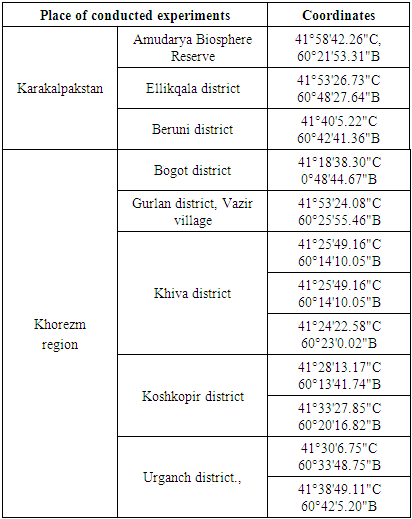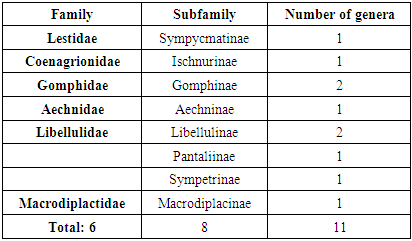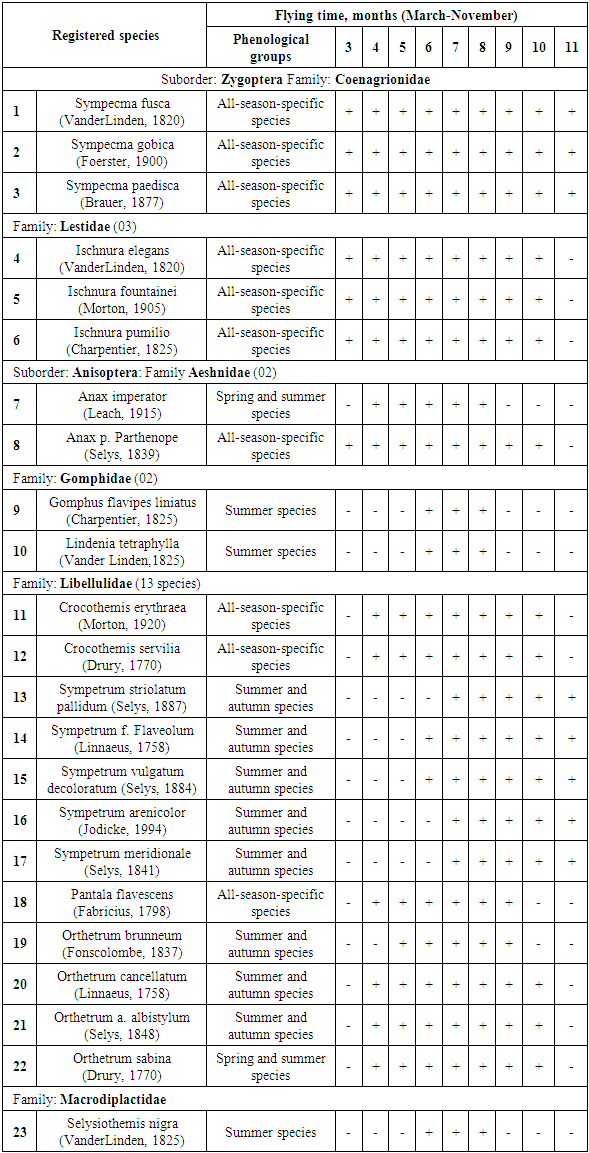Akhmedova Mokhira Shavkatovna1, Doschanov Jalolbek Saparboyevich2
1Khorezm Mamun Academy, Khiva, Uzbekistan
2Senior Researcher of the Department of Natural Sciences, Khorezm Mamun Academy, Khiva, Uzbekistan
Correspondence to: Doschanov Jalolbek Saparboyevich, Senior Researcher of the Department of Natural Sciences, Khorezm Mamun Academy, Khiva, Uzbekistan.
| Email: |  |
Copyright © 2022 The Author(s). Published by Scientific & Academic Publishing.
This work is licensed under the Creative Commons Attribution International License (CC BY).
http://creativecommons.org/licenses/by/4.0/

Abstract
This article presents the species composition and phenology of dragonflies distributed in the Khorezm oasis. When analyzing the results of the observations made in 2020-2021, four phenological groups were noted: spring-summer species, summer species, summer and autumn species, all-season-specific species (spring, summer, autumn). Accordingly, all-season-specific species (10 species) were numerically superior to others.
Keywords:
Imago, Phenology, Seasonal rhythm, Biotopes
Cite this paper: Akhmedova Mokhira Shavkatovna, Doschanov Jalolbek Saparboyevich, Phenological Groups of Dragonflies (Insecta: Odonata) in Khorezm Oasis, International Journal of Genetic Engineering, Vol. 10 No. 2, 2022, pp. 17-20. doi: 10.5923/j.ijge.20221002.01.
1. Introduction
Abiotic factors, such as climate (temperature, air humidity, light) are important for the lifestyle of insects. Sudden changes in temperature throughout the year create unfavorable conditions for some species, while others develop adaptations and continue to survive. Representatives of the family of dragonflies (Insecta: odonata) are amphibious insects. Their lifestyle is directly related to the water, and the appearance of the imagos and their flight depends on the temperature of the water [10]. According to the results of observations, the periods of seasonal activity of all dragonfly species increase from north to south.
2. Literature Review
All species of dragonflies are active mainly in the first half of the day in spring and late autumn. At the end of the spring season and the beginning of the summer season, species are divided into two: species that are active in the evening and species that are active in the daytime [1]. According to the opinion of most odonatologists, besides the climate, the geographical condition of the area (plain, hilly or mountainous area) is also important to the main factors influencing the flight patterns of insects. Sometimes a sudden increase in air temperature in the last days of winter or in early spring can cause the emergence of early spring species [2].During our research, the seasonal activity of dragonflies spread across the plains of the Khorezm oasis was studied, and the emergence periods of dragonflies were studied by dividing them into phenological groups.
3. Research Methodology
Khorezm oasis, sometimes Khorezm oasis located in the lower reaches of the Amu Darya River. It occupies the entire territory of the Khorezm province of Uzbekistan, the southern part of Karakalpakstan (an autonomous republic within Uzbekistan), as well as the northern and northeastern parts of the Dashoguz province of Turkmenistan. The center of the ancient historical region of Khorezm [9].The surface of the region mainly consists of plains, it has completely changed as a result of human economic activity and turned into an anthropogenic landscape. The area has an average height of 90-108 meters above sea level and is part of the plains of Uzbekistan. The climate is continental with moderately cold winters and dry hot summers. The lowest temperature is -32 C, the highest temperature is +47 C. In the oasis, Amudarya supplies water to all canals and cultivated fields [7]. Large salty lake and small lakes and artificial fisheries are well developed in the region. Biomaterials were collected from water bodies in the Khorezm oasis in 2020-2021. Dragonflies in the imago stage were collected from places near water bodies, lakes, irrigation networks. The coordinates of each monitored area were determined by mobile phone (Table 1).Table 1
 |
| |
|
Determinants were used to identify species [3], [5], [6], [8]. Phenological observations were carried out in all seasons of the year, from the time when the dragonflies leave the nest in the spring months until they leave for the winter, and special attention was paid to the following situations: the natural climatic conditions of the Khorezm oasis, the time of the first emergence of the imago stage, the laying of eggs by the dragonflies, which were observed at the end of the season, their last individuals. Based on the analysis of the literature and the results of the observations, we divided the phenological periods of dragonflies into 4 groups:1. Spring and summer species2. Summer species3. Summer and autumn species4. All-season-specific (spring, summer, autumn) species [2], [4], [5].
4. Analysis аnd Results
During 2020 and 2021, dragonflies belonging to 2 suborders, 6 families, 8 subfamilies, 11 genera, 23 species were found in three biotopes of the Khorezm oasis (Tables 2, 3).Table 2
 |
| |
|
Table 3
 |
| |
|
The activity of the flight periods of dragonflies was also studied in the months from March of the spring season to late autumn and winter. Based on the collected data, the development of dragonflies in the Khorezm oasis starts from the last ten days of March and continues until the end of October or, for some species, the first ten days of November. (Table 2) In general, the flying activity of dragonflies in the Khorezm oasis lasted for 9 months during the year.Spring and summer species. These species were observed to be active, when the temperature of the spring season exceeds +10 degrees. Their period lasts from the third ten days of March to the last days of August. By the second ten days of April, Anax imperator (Leach, 1915), belonging to the genus Anax, can be found in orchards, around lakes and ditches. By the first 10 days of May, Orthetrum sabina species begins to fly. We have actively recorded this species in all biotopes. Also, in the last days of May (2021.V.22), in the observations made in the Amudarya Biosphere Reserve, it was observed that Anax imperator, Anax parthenope species came to artificial lighting at night. By the summer months, a sharp increase in air temperature and the influx of dry hot air causes the species to actively hunt at night (Borisov, 2007).Summer species were found in June, July, August. Species such as Gomphus flavipes, Lindenia tetraphylla were found from the second ten days of June, from the middle of June, to the second ten days of July, August. The Gomphus flavipes species was found in areas typical of the agro-landscape biotope. It is noted that the larvae of this species were found in running water. We met Lindenia tetraphylla species mainly in groves near the Amudarya, and around water bodies with thick reeds, in the Amudarya Biosphere Reserve-in the process of spawning, breeding and hunting. The colors of the imagos of these species are light yellow and gray.Summer and autumn species. In this phenological group, we include species belonging to the Anisoptera suborder, which are active from the second ten days of June to the first ten days of October. In particular, S. Arenicolor was found around forests and lakes from the second half of June to the end of September. A species close to the desert biotope was observed in large numbers in all observed areas of the Khorezm oasis. S. f. flaveolum species is active from July to the beginning of September. This species was observed in small numbers in the studied territory. Being suitable for agrolandscape biopic, this species was found mainly near cultivated fields. S. vulgatum decoloratum was found in large numbers from June until almost mid-November (when the autumn season was warm). S. meridionale was found from the beginning of July to the end of September. It was observed mainly along the water. S.striolatum pallidum was found from the second ten days of July until late autumn. It was found in large numbers at the beginning of warm November, at +15, +20 degrees, on sunny days (12.xi.2020, Urganch district).All-season-specific species (spring, summer, autumn). In early spring, you can find S. paedisca, S. fusca, S. gobica species belonging to the genus Sympecma. Since members of this genus are imago-wintering species, it was observed that they flew actively during the anomalous temperature rise in late February or early March (03.III.2021). On hot summer days, it was observed in gardens, shade in cool cultivated areas and trees in dark places. Also, until the end of the season, we observed the imagos of Sympecma species in the state of wintering in reeds around lakes and ditches. In addition, it was observed in orchards around Urganch district, Cholish post, Amudarya in November 2020, in the second 10 days, when the temperature was +12, +15 degrees. They were observed in large numbers on sunny days. In the last ten days of April, when the temperature is +12, +20 degrees, such species as A. parthenope, C. erytheria, C. servilia, P. flavescens, belonging to this phenological group begin to fly. Also, until the end of the season, we observed the imagos of Sympecma species in the state of wintering in reeds around lakes and ditches. Moreover, it was observed in orchards around Urganch district, Cholish post, Amudarya on the second 10 days of November 2020. The fact that the Central Asian countries are mostly sunny for 9 months during the year ensures the activity of dragonflies until late autumn [1]. Therefore, it was a bit difficult to separate them into phenological groups. In some cases, at the end of February and at the beginning of March, when the temperature suddenly exceeded +12 degrees, we witnessed the emergence of I. elegans, I. fountainei, I. pumilio S. fusca, S. gobica species belonging to the suborder Zygoptera. By late autumn, a sharp drop in temperature became a limiting factor for autumn species. In 2020, the activity of representatives of the genus Sympetrum was observed until November 20, and in 2021, we can see that the temperature drops below zero by October 15 as a limiting factor for the dragonfly fauna. In the course of the conducted research, the all-season-specific species formed the largest number.
5. Conclusions
According to the results of the conducted research, the seasonal activity and phenology of dragonflies were monitored at 12 points (Table 1) in Khorezm Oasis during 2020-2021. There are four phonological groups: Spring and Summer species – 2; Summer species – 3; Summer and Autumn species- 8; All-season-specific-species- 10 (Fig. 1). Seasonal activity of dragonflies started from the second ten days of April and continued until the last ten days of October, when the temperature reached +20 degrees. According to some late autumn observations, it was observed that the species Sympetrum vulgatum belonging to the genus Sympetrum, the species Sympecma fusca belonging to the genus Sympecma were also active in November when the temperature was +10 C, +12 C (2020.xi.12). Seasonal activity of dragonflies in the oasis can last up to 8.5 or 9 months, depending on the temperature. | Figure 1. Phenological groups of dragonflies in Khorezm Oasis |
References
| [1] | Borisov S.N., A.Y. Kharitonov, Dragonflies (Odonata) of Central Asia. Part 1. Caloptera, Zygoptera. Eurasian entomol. Journal 6(4): © EUROASIAN ENTOMOLOGICAL JOURNAL, 2007. 343–360 pp. |
| [2] | Belyshev B.F., Kharitonov A.Y., Borisov S.N. etc. Fauna and ecology of dragonflies / - Novosibirsk: Science. Sib. department, 1989. - 207 p. |
| [3] | Kazenas V.L, E.I.Malikova, S.N. Borisov, Dragonflies (Species Arthropods, class Insects). Series “Animals of Kazakhstan in photographs”. - Almaty, 2014. - 176 p. |
| [4] | K.-D. Dijkstra & V.J. Kalkman Early spring records of Odonata from southern Turkey, with special reference to the sympatric occurrence of Crocothemis erythraea (Brullé) and C. servilia (Drury) (Anisoptera: Libellulidae). Notulae Odonatologicae 5:, 2001. 55-88pp. |
| [5] | K.-D. Dijkstra,. & R. Lewington, Field Guide to the Dragonflies of Britain and Europe,London: British Wildlife Publishing, 2006, 320 pp. |
| [6] | Skvortsov. E.V. Dragonflies of Eastern Europe and the Caucasus: Determinant Atlas. - M.: Association of scientific publications KMK, 2010. 624 pp. |
| [7] | Rozmetov D., M. Matchanov, U. Kalandarov. Agricultural geography of Khorezm region. Educational manual, Urganch State University. Urganch, Urganch State University Publishing Department, 2017. 164 pages. |
| [8] | Subramanian K. A., Dragonflies (Anisoptera) // Dragonflies and Damselflies of Peninsular India — A Field Guide. E-Book of Project Lifescape / Madhav Gadgil. — Bangalore, India: Centre for Ecological Sciences, Indian Institue of Science and Indian Academy of Sciences, 2005. 59. — 118 pp. |
| [9] | https://ru.wikipedia.org/wiki/ |
| [10] | Odonata | insect order - Encyclopedia Britannica https://www.britannica.com/. |




 Abstract
Abstract Reference
Reference Full-Text PDF
Full-Text PDF Full-text HTML
Full-text HTML

